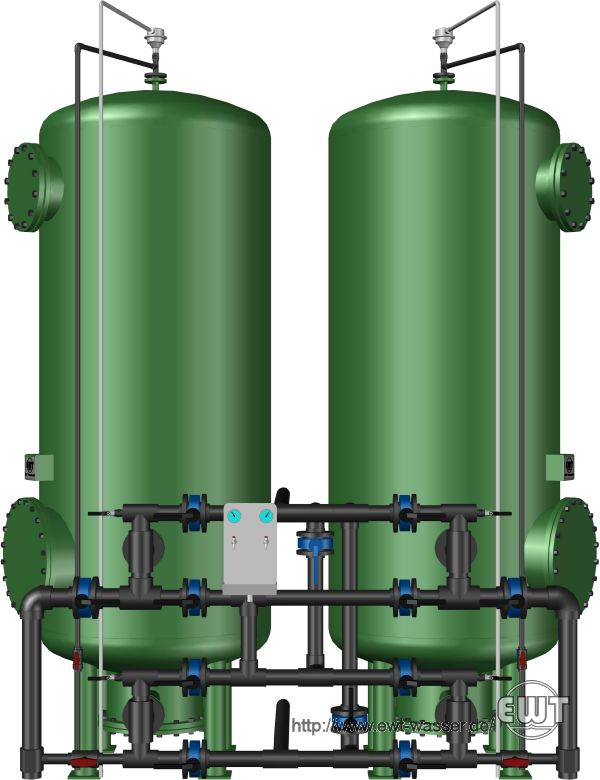

← Home • Products • GAC Filter ↓ Summary • Design Example •Applications • Technical Data • Downloads
In water treatment, a granular activated carbon filter (short: GAC filter) serves for removal of certain dissolved or suspended molecular substances, or of certain emulsified liquids, primarily by means of adsorption. The adsorbent (or "filter" material) is a packed bed of granular activated carbon, with equipment and filter vessel design (but not process design) being basically identical to actual bed filters, e.g. →sand filters. Typical applications are removal of organic compounds (e.g. measured by TOC = total organic carbon), removal of oil and grease, or removal of chlorine.
With increasing service life, the granular activated carbon adsorbent will eventually become depleted, and need to be replaced. This is due to the useable active surface of the adsorbent being reduced by adsoprtion of the adsorbate, but for certain applications also biological fouling, or – in case of chlorine removal – consumption of the adsorbent due to chemical reactions.
As a side effect, a GAC filter also acts as an actual filter, thus possibly requiring periodic backwash with water in order to remove filtrated suspended solids from the filter bed, depending upon the raw water quality.

GAC filter plant, two lines in lead/lag configuration, with manual line change-over and backwash with raw water.
| purified water volume flow |
available from approx. 1.5 up to 60 m³/h per line for TOC removal available from approx. 1.5 up to 60 m³/h per line for removal of oil and grease available from approx. 1.5 up to 180 m³/h per line for removal of chlorine |
|||
| amount of lines |
usually 2x50% lead/lag configuration 100% + 100% smaller plants also 1x100% larger plants also 3x33% oder 4x25% |
|||
| removal of adsorbate, for each treatment stage | TOC | ≥ 30% ... 80% | ||
| oil and grease | ≥ 90% | |||
| chlorine | > 90% ... 99.9% | |||
| differential pressure at nominal flow rate | usually ≤ 0.5 bar | |||
| operating temperature |
usually 5 ... 40 °C condensate polishing ≤ 110 °C |
|||
| backwash intervals | usually 24 ... 720 h | |||
| backwash duration | approx. 15 minutes, for water backwash | |||
| backwash water volume flow | usually operating volume flow × 1 ... 2 | |||
| waste water | approx. 0.2 ... 40 L for each 1 m³ purified water | |||
| recommended raw water quality | total suspended solids (TSS) | ≤ 1 ... 10 mg/L | ||
| TOC | depending upon design and application | |||
| oil, grease | depending upon design and application | |||
| chlorine | depending upon design and application | |||
| adsorbent | granular activated carbon | |||
| total service life of the adsorbent | usually 3 ... 24 months | |||
| material options | pressure vessel |
• glass-reinforced plastic (GRP) • carbon steel (e.g. S235JR, P265GH), coated • stainless steel (e.g. 1.4306, 1.4404) |
||
| pipelines |
• polyvinyl chloride (PVC) • polypropylene (PP) • stainless steel (e.g. 1.4571) |
|||
| valves |
• polyvinyl chloride (PVC) • polypropylene (PP) • stainless steel (e.g. 1.4408) |
|||
| gaskets |
• etyhlene propylene diene monomer rubber (EPDM) • polytetrafluorethylene (PTFE) • NBR composite |
|||
| control options | differential pressure monitoring |
• local display • remote measurement |
||
| quality monitoring |
• manual sampling and analysis • continuous Cl2 measurement • continuous redox measurement • continuous TOC measurement • continuous turbidity measurement |
|||
| line change-over |
• manually • fully automated |
|||
| backwash |
• manually • fully automated |
|||
2018-05-05 • water treatment made in Germany • Company Information • Privacy